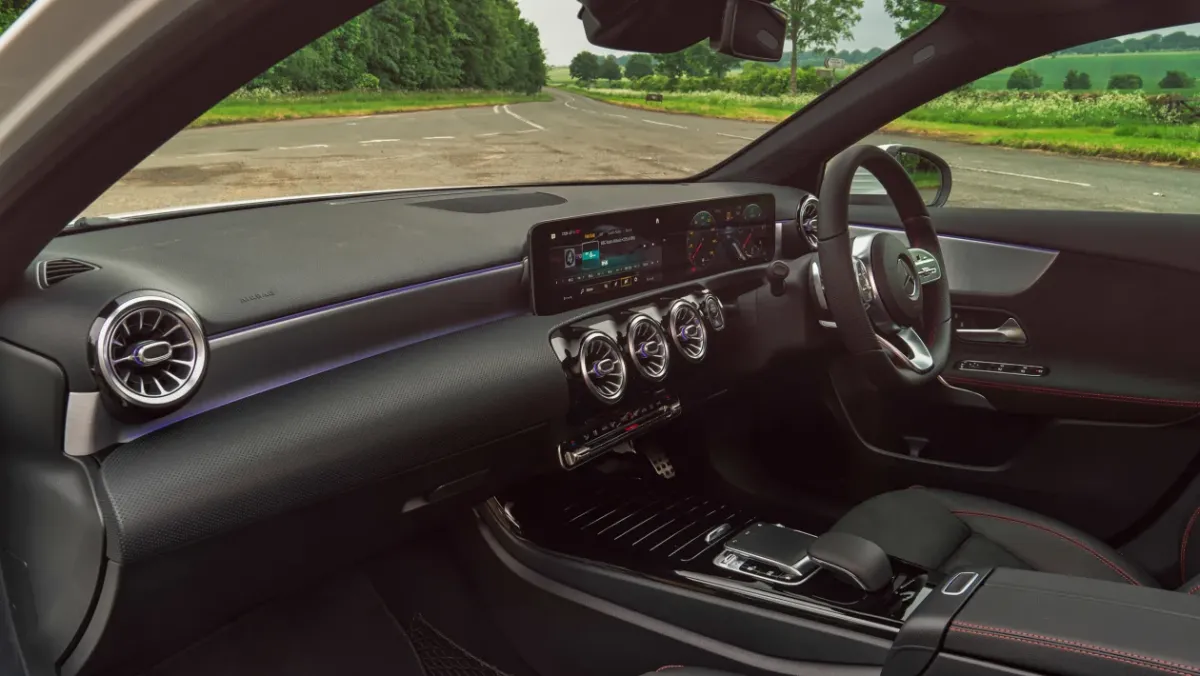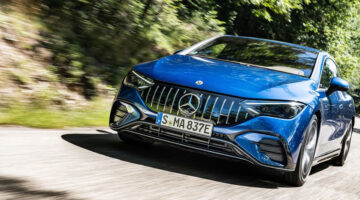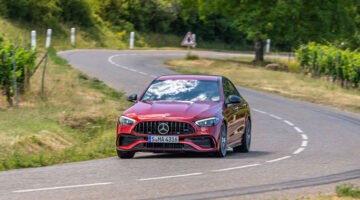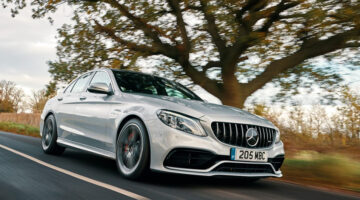Now in its fourth generation, the Mercedes A-class is unrecognisable from the car that kicked things off two decades ago.
PRICE: From $28,850
| Class-leading tech, luxurious interior, rapid A35 | |
| Poor ride, some unimpressive engines |
The first two
By the time the second-generation A-class had arrived, Audi and BMW’s own small cars – the A3 and the 3-series compact (and later 1-series) had nailed the balance of a premium feel and compact size that an increasing number of customers craved. leaving the intelligent but ungainly A-Class out of favour buyers now more concerned with image than intelligence.
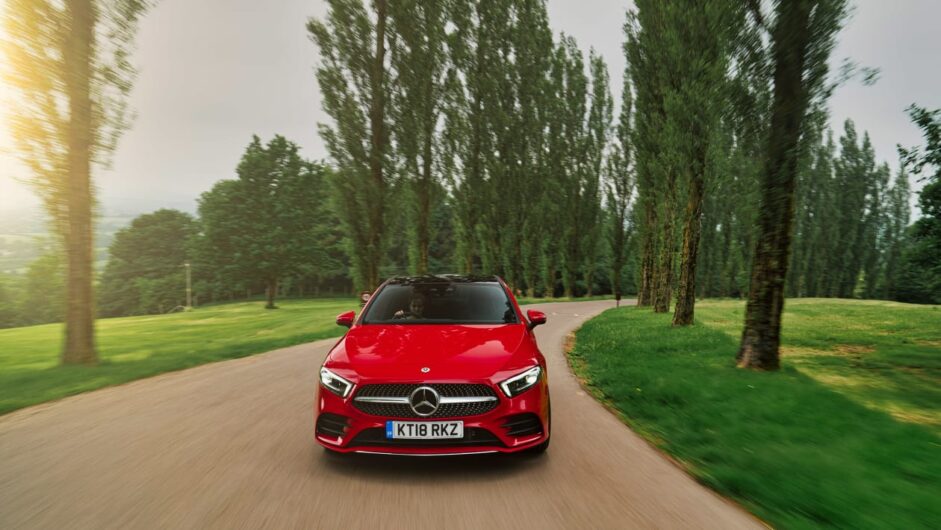
If you can’t beat ‘em, join ‘em. The third-generation A-class ditched the sandwich floor and lofty seating position and went down the conventional two-box hatchback route. Sales went gangbusters and diversification into saloons and estates (with the CLA line), mini-MPVs (B-class) and hot hatchbacks (the AMG A35 and A45) strengthened its position further.
With this fourth-generation A-class, more technologically advanced and sleekly styled than ever, Mercedes is hoping to replicate that feat. With sharper looks, a striking cabin, new engines and E-class levels of technology it works on paper, but it also has to impress on local roads.
Initial impressions suggest it’s a more appealing car in the showroom than it is on the road, with solid but otherwise dull handling and a sometimes choppy ride quality make it feel ultimately a car that’s less about the driving experience and more about how big of a Mercedes badge you can fit onto the nose. Still, as you go up the range, the A-class steadily gets more and more impressive, and there’s also no doubting its efficiency which will almost certainly be a consideration for many buyers.
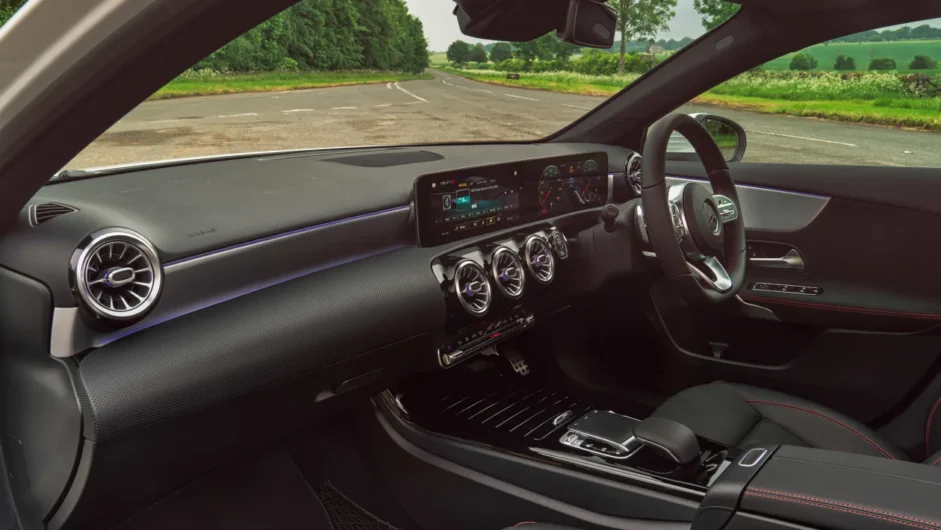
Prices, specs and rivals
A combination of manufacturing constraints, low supply and high demand has made all A-classes shoot up in price with the entry level A180 Sport coming in at a whopping $35,930, putting it way above mainstream rivals and nearly $10,000 more than when it was launched in 2018.
Cough up an extra $1600 and the entry-level A180d diesel is available at $37,510, also in Sport trim. Climbing the range, the 160bhp A200 Sport will set you back $37,745 the diesel A200d Sport almost $39,000. The more popular AMG-line cars begin at $36,400 for the A180, and top the range off at $43,820 for the ridiculously named A200d AMG Line Premium Plus Night Edition. A more recent addition is the A250e which starts at $42,530 in its simplest AMG Line Executive form, and tops out at $46,850 for the Night Edition. As for the AMGs, the A35 starts at $48,540, the full-fat A45 is now an eye-watering $68,623.
To take full advantage of the tech on offer, you’ll want to spend a bit extra to equip the dual 10.25-inch screen infotainment system as opposed to the 7-inch units fitted as standard. The Premium packs offer the same upgraded infotainment screens alongside 64-colour ambient lighting, keyless go, an upgraded sound system and a few other toys too. Pricing is higher than for many rivals, with the admittedly lower-specification Audi A3 Sportback 1.0 TFSI Technik starting at $30,465, or a BMW 118i SE at $31,835.
Engine, gearbox and technical specs
Kicking off the range are the A180s, in both petrol and A180d diesel form. The entry-level A180 uses a 1.6-litre four-cylinder petrol engine with 136PS and a six-speed manual transmission. The A180d is next, and the first we’ve driven ourselves, using a 1.5-litre turbocharged diesel producing a modest 114bhp but a more useful 192lb ft of torque from 1750-2500rpm. Mercedes claims 4.6L/100km combined economy from the diesel on the latest WLTP test procedure. Our drive suggests
Next up is the A200, an all-new 1.3-litre turbocharged petrol four-cylinder co-developed with Renault, with a reasonable turn of pace. Despite the modest capacity it boasts a 161bhp output and 184lb ft at 1620rpm, only lagging the diesel slightly on torque, though as you’ll read in the next section, its delivery isn’t quite as pleasant as that of the diesel, requiring more revs for a given task and making a strained noise as it does so.
An A200d follows, at 2.2 litres in capacity and with 136PS and 300Nm to call upon. Above that in the diesel range is the A220d, now making 177PS and 350Nm from the same 2.2-litre turbocharged diesel, while the next petrol up is the 187bhp A220, using a 2-litre turbocharged four.
The A250 packs the same unit but delivers 221bhp, 258lb ft from 1800rpm, meaning it has enough power to make unruffled progress in day-to-day driving and enough in reserve to propel you down a twisty road at a decent lick. It’s smoother than the smaller petrol too, to the benefit of refinement, though it still doesn’t feel much like an engine you’ll be inclined to rev. While new, tight engines never quite give their best and a more run-in unit might feel more willing, the 2-litre still feels like an engine best driven in its low to mid-range.
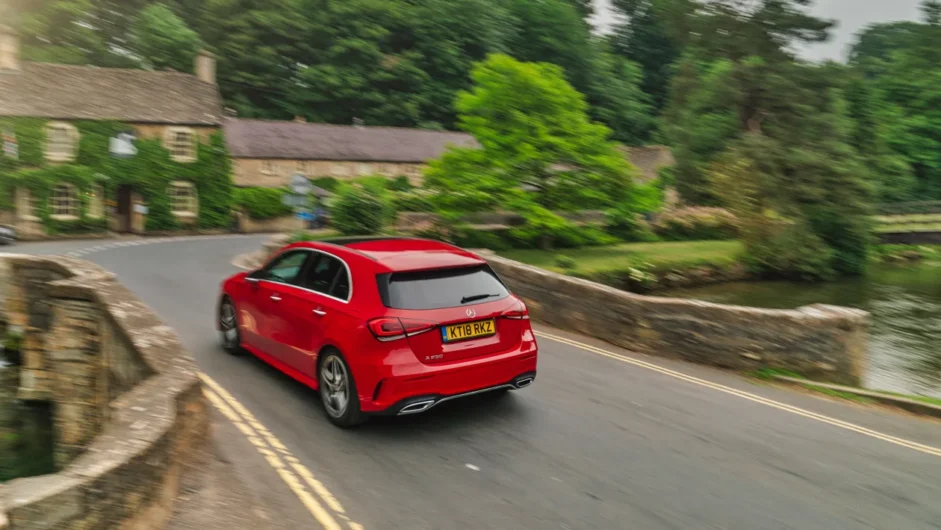
Transmission choices are fairly confusing, but we’ll give it a go. A six-speed manual is standard on the A180 and A200, while a seven-speed automatic is the standard transmission for the A180d. Mercedes puts an 8-speed dual-clutch auto in the A200d and A220d, but the petrol A220 and A250 revert back to the seven-speed auto. 4Matic all-wheel drive comes in with the A220, and is also available on the A220d and A250.
Kicking off the AMG range is the A35, which packs a healthy 302bhp and 295lb ft making it quick enough to keep and Audi S3 and VW Golf R honest. Unlike the A45 it doesn’t use a bespoke AMG unit, utilising instead a modified version of the A250’s M260 unit. Changes run to a twin scroll turbocharger and an air to water intercooler, plus the inevitable overhaul of the car’s electronic brain. The seven-speed auto is familiar and is connected to a recalibrated version of the A220 4Matic’s all-wheel drive system.
To help meet ever-stricter emissions standards, all petrol units feature particulate filters – something you’ll see rolling out across an increasing number of petrol cars in the years to come.
Mechanically the new A-class is fairly unremarkable, with a steel structure (slightly wider and longer than before, liberating greater interior and luggage volume) and MacPherson struts with passive dampers at the front. The rear setup varies depending on spec, with all SE and
For the A35 virtually no suspension component is carried over from the regular A class, with re-designed joints and lower wishbones combined with careful development of the bushes and even the use of metal bearings on the lower front arms for more steering precision. The rear subframe is now solidly mounted to the body, while the steering rack is also new for the A35, as are the beefy brakes with monoblock four-piston calipers up front. There’s a stiffer structure to work with, too, courtesy of an aluminum shear under-panel beneath the engine, assisted by bracing bars.
Performance and 0-100 time
With eight four-cylinder power units and three gearboxes to choose from it takes a little while to work out the A-Class performance hierarchy.
AMGs top the list, with the A35 and A45 both pairing (different) 2-litre four-cylinder petrol engines with all-wheel drive and eight-speed dual-clutch transmissions. The A35’s 0-100kph is taken care of in 4.7 seconds and comes with an electronically-limited top speed of 250kph, while the A45 will do the same in just 3.9sec. Next up is the 2-litre A250e plug-in, capable of sprinting to 100kph in a brisk 6.6 seconds and reaching the same restricted 250kph.
Moving down the range, the A200 and A180 petrols pair a 1.3-litre four with a seven-speed dual-clutch, both crack 100kph in well under 10 seconds and will happily push past 209kph. Slowest of the bunch is the diesel powered A180d that needs 10.5sec to get to 100kph and will top out at 200kph. The A200d uses the same 2.0-litre diesel, and will post an 8.1sec 0-100kph time.
Initial impressions are good, with all units feeling quiet and vibration-free at idle. All engines also feel quite responsive to initial throttle inputs even in Comfort mode, but only the A250 and A35 continue to leap forward as you sink the pedal further. The A180d and A200 petrol we’ve tried provide extra noise but limited thrust. The diesel may actually be the preferable of the pair, as while it’s slower than the petrol, its low-down torque characteristics mean you don’t need to work it as hard in typical driving.
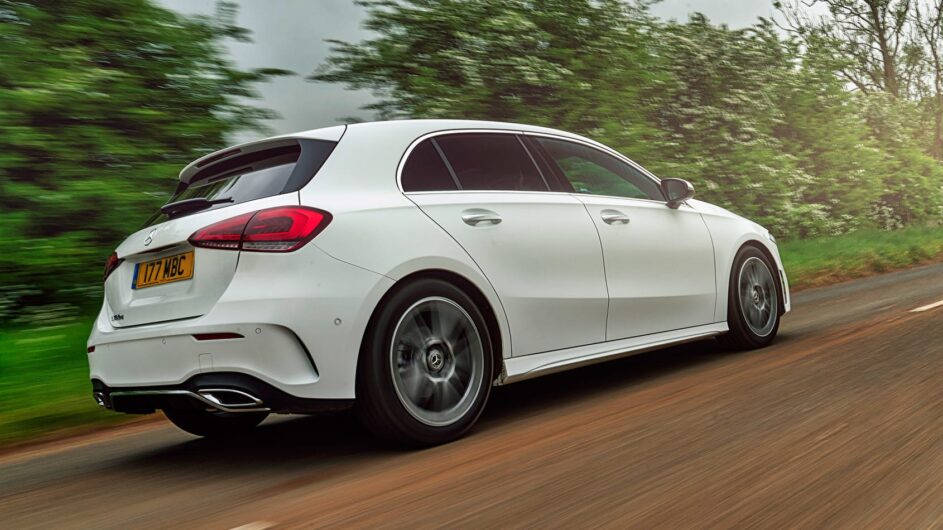
Given the A200’s harshness and the A180d’s relative smoothness, we’d say the diesel is the pick of the smaller units.
The A250 isn’t exactly bustling with character. It’s smoother than its smaller petrol sibling and doesn’t need stoking as much to get you down the road, but it’s still a relatively joyless thing to rev and the DCT ‘box makes a meal of quick getaways, without the reward of a truly snappy change when you’re selecting manually with the steering wheel-mounted paddles.
You probably won’t feel compelled to switch to Sport mode very often either, which drops a couple of ratios and makes the initial throttle response overly sensitive – Comfort mode is best, using the paddles to change gear manually when required. Ultimately though the new A-class isn’t yet a car that goads you into a more lively driving style – it’s at its best simply cruising along quietly with everything set to auto.
In most scenarios the DCT is quick and slick enough, but it can be wrong-footed by an unexpected downchange request, while hurried getaways at junctions and roundabouts can result in an uncomfortable lurching as the gearbox fails to keep up with the demands of your right foot. Unlike the other models however, Sport+ mode is preferable here, ideally with the transmission in manual mode. Configured such, you can keep up good pace without slovenly eco-biased gearchanges or needless revs, and enjoy the occasional barrage of pops and crackles.
Ride and handling
The old A-class always rode poorly, so it’s disappointing to find the latest model is little better. The multi-link cars are more adept at dealing with broken and rough road surfaces than the torsion beam models lower down the range which clonk and shudder more readily, but on the AMG Line’s 18-inch wheels and 40-profile tyres, both setups feel unsettled on all but the smoothest surfaces, rumbling noisily over patchy tarmac and thudding over harsher bumps.
This firmness does translate to good body control and roll is kept to a minimum, backed up by strong levels of lateral grip. The steering is reasonable too, with a responsive and well-weighted feel once past a slightly dead zone around the straight-ahead, and once you’re up to a decent speed and sending greater loads through the front axle. There’s a typical Mercedes slickness to the steering too, even if the suspension’s struggle to contain bumps sometimes sends vibrations through the rim.
With little feedback though the A-class lacks involvement, so there’s not much fun to be had slotting the A-class down a twisting section of road, even though it’s capable of doing so with speed and composure.
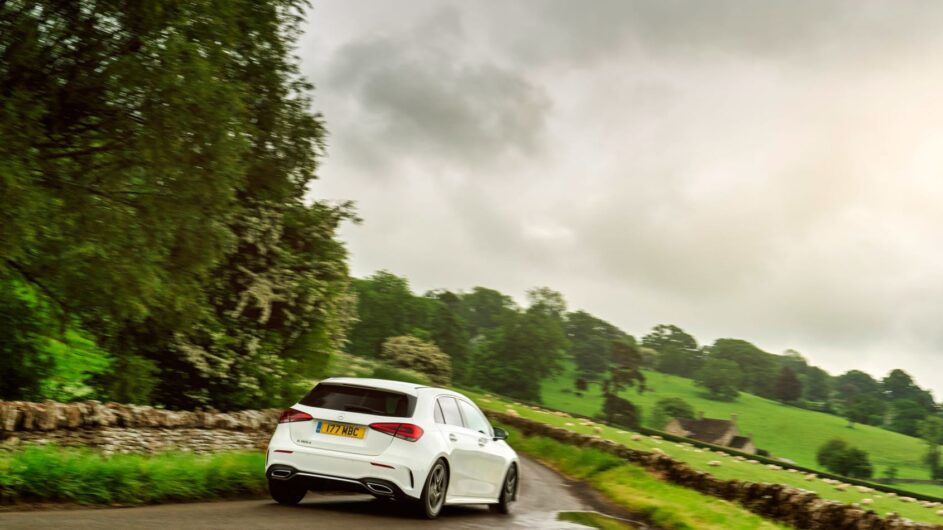
However, the A35 proves that there’s actually a solid base underneath the A-Class. It’s not perhaps as engaging and adjustable as a VW Golf R, but as a device to pick apart a twisting road it’s very impressive. The steering is quick and accurate, if relatively low on road feel, but there’s more substantial weighting than you’ll find in the Golf, which is actually quite confidence-inspiring on unfamiliar roads.
There’s plenty of turn-in bite, particularly in the dry when the grip feels near-endless There’s also a feeling the front and rear axles are working together, giving the car a lovely four square stance. This isn’t a Focus RS style oversteerer, but the four-wheel drive transmission’s switch from front-wheel drive to 50-50 torque split is so quick (it’s already priming the centre diff before you’ve got on the throttle) you can fire out of corners with your right foot buried without fear of falling off.
Body control is superb too. There’s very little to choose between the Comfort, Sport and Sport+ driving modes in cars with adaptive dampers (even Comfort gets a little agitated over most surfaces), with the middle setting just about offering the best fast road compromise between comfort and composure. The brakes deserve special mention, offering both tireless stopping power and beautifully judged pedal progression.
L/100km and running costs
Other variants will inevitably follow, but for the time being the A180d is the predictable economy champ with a combined figure of up to 4.6L/100km (and 110g/km of CO2) on the new WLTP cycle. Gentle, steady motorway driving is likely to return the best figures in the real world, but our mixed route on the car’s launch saw around 5.1L/100km on the trip computer – reasonable, but not outstanding. An A200d in Sport trim offers 5L/100km.
The A200 was around 28L/100km behind the A180d in similar mixed driving, against an official combined figure of 6.3L/100km (for a corresponding 136g/km of CO2), so got admirably close to its official numbers.
With most on-the-road prices of under $45,000, none of the basic A-class models attract the VED surcharge of $360 a year, so a basic A180d will cost $170 in year one and $160 a year thereafter, the A200 is $240 in year one, and the A250 also comes in at $240 in year one. Hit the options list hard and you may find A250s attracting that $360 yearly surcharge.
Interior and tech
When the current A-class debuted, its neat horizontal layout to the dashboard, wide instrument panel display and simplified centre console made everything else in the class seem staid and unimaginative. Yet now, even just a few years later its a design theme that’s been picked up across the industry, in the process drawing attention away from the shiny screens and slick graphics, and instead concentrating on the actual quality of materials.
Dig deeper and there are perhaps one or two too many different types of material on display and the traditional Mercedes steering column mounted gear selector (and its combined wipers and lights stalk on the other side) both looks and feels oddly cheap. Despite this, the layout and appearance remain appealing and the absence of bulky mouldings lends an airy feel, despite the gloomy black trim of the AMG Line cars we drove. A range of adjustment to the wheel and seats and well-placed pedals make for a comfortable driving position too.
Technologically it’s right on the button. At its flashiest the A-class cabin uses a pair of 10.25-inch displays, with the central display now touch-sensitive. That’s just one of the ways you can now control it, the others being a touchpad in the centre console, buttons and touch-sensitive pads on the steering wheel spokes, and voice commands as part of what Mercedes calls MBUX.
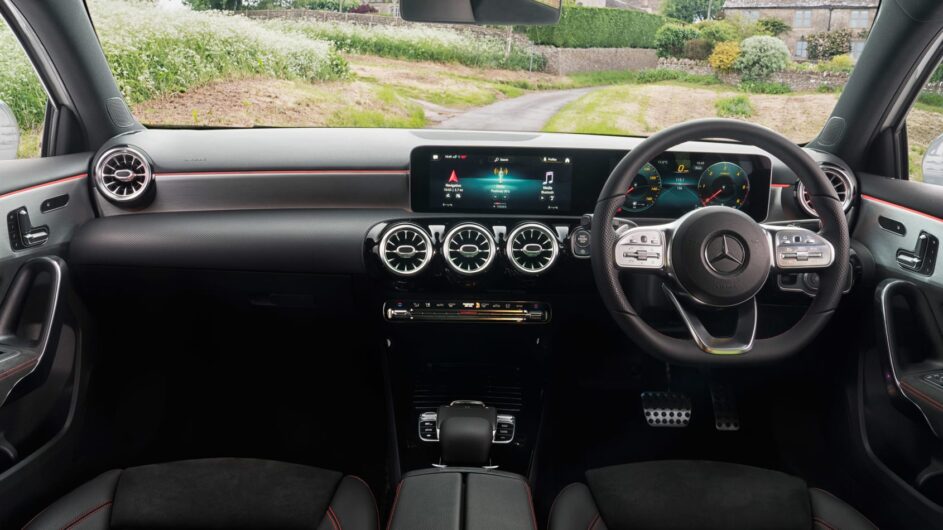
All methods work surprisingly well, and the voice control system is among the best we’ve tried. It’s still unfamiliar with some commands, but by and large it’s quite easy to set navigation destinations, change radio stations, adjust the interior temperature or just change the ambient lighting colour with simple spoken instructions. As a means of distraction-free control of infotainment, it’s better than any touchscreen.
The various displays are of course multi-configurable, and the touch-sensitive elements allow you to use smartphone-style pinching, swiping and scrolling movements, with simple “back” buttons present on all surfaces – a useful shortcut to whatever screen you were on before, so you don’t end up eight menus away from your navigation directions or other similarly irritating predicaments.
Once you’ve spent a good while prodding and swiping at the steering wheel buttons and the central touchscreen you’ll eventually settle on an instrument layout that suits you too – virtually every element of both screens can be configured to suit, or you can just select one of the themes Mercedes has already programmed in, from a sporty layout, to one themed around economical driving, to another that removes virtually all visual elements from the screen for distraction-free driving.
One really neat touch is the augmented reality sat-nav directions. Approach a junction or a roundabout and the map on the centre screen is replaced by the view from the front-facing camera, which is then overlayed with an arrow showing your route. It’s a brilliantly simple and intuitive piece of kit.
Design
Visually the new A-class still has close links to its predecessor, with a relatively unremarkable two-box form that’s identifiable as a Mercedes-Benz more from its details than any consistent Mercedes design language (and it still lacks the innovation of the first two A-class generations) but place new next to old and there’s little doubt the new car is more attractive than before.
In standard
The bonnet line seems lower and the new front end with its slimmer grille and headlights is less porcine than before. The same applies to the rear end, though the thinner tail lights sit less comfortably here in what’s still a relatively chubby rump.
Things are better down the sides, where Mercedes’ new design direction has led to much cleaner surfacing without the random cuts and slashes present in the old car’s panelwork, and overall the car looks like it’s been on a bit of a diet – even if, with a starting kerbweight of 1375kg, it’s only 20kg lighter than before.
This article originally appeared at evo.co.uk
Copyright © evo UK, Dennis Publishing

